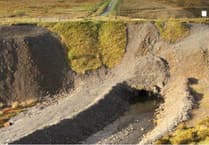Scientists have criticised authorities over their misguided strategy that could see Fairbourne abandoned and its residents made ‘climate refugees’ without new flood defences
A source from the village, who did not want to be named, said residents have not ruled out a future bid for reparations after Gwynedd Council’s ‘lies’ about the village being ‘decommissioned’ - demolished and depopulated by 2054.
In 2013 Gwynedd Council confirmed it would spend no more money defending Fairbourne against rising sea levels and flood encroachment – committing to so-called ‘managed realignment’ or measures which would soon prepare the village for ‘relocation’.
Residents of the seaside village vehemently opposed the idea their homes would be abandoned – and have always rejected their labelling as the UK’s first climate refugees.
Speaking to the Cambrian News in January, residents decried the dreadful damage councillors and officers did to the community by openly discussing the possibility the village, home to 700 people, would be allowed to return to the sea. Residents saw house prices plummet almost overnight due to distorted media reports when the decision was made public.
But now Gwynedd Council appears to be rowing back on the idea, with correspondence suggesting officials are ready to ditch previous commitments to ‘decommissioning’ – a strategy for which has never been clearly articulated nor gone before full council – and the 2054 ‘doomsday’ deadline.
Despite suggestions the strategy would adapt to scientific developments, the authority has this week rejected analysis of the risks to the village, from rising sea levels and seasonal storms, which calls into questions the council and environmental regulator Natural Resources Wales’ (NRW) strategy.
In January, the authority and NRW agreed to peer-review the work of former Aberystwyth University geologist Dr Graham Hall – which has this week been publicly endorsed by Professor Tony Jones, one of the world’s leading hydrologists, and an aquatic ecology academic and senior research fellow at the University of Hertfordshire, Dr Veronica Edmonds Brown.
But authorities dismissed its findings and doubled down on their commitment to the plan as laid out in 2013.
The West of Wales Shoreline Management Plan 2 was compiled by environmental regulator Natural Resources Wales (NRW) in conjunction with Dutch engineering consultancy Royal Haskoning. It was adopted by Gwynedd Council along with other regional authorities. It commits Fairbourne to ‘managed realignment’ or ‘retreat’ – but does not use the term ‘decommissioning’ nor commit to a fixed year.
NRW officials have previously suggested that sea levels will rise by an average of 4.7 millimetres every year. The Welsh Government predicts levels will rise on the nation’s coastline by about a metre over the next century, leaving coastal areas at risk. Modelling from charity Climate Central – based on Intergovernmental Panel on Climate Change data – estimates the roads nearest to the shoreline could be gone in less than two decades.
But Dr Hall modelled alternative outcomes for sea level rise over the next century and has criticised the ‘non-peer reviewed’ reports used to justify the strategy for Fairbourne.
He and his wife said in an article that went to the Welsh press that it would be cheaper to defend Fairbourne than to decommission it and it criticises modelling as outdated and preparing for the ‘worst-case scenario’.
It also says the costs of reinforcing Fairbourne’s sea defences for the next century need only be around £10 million rather than the £115m projected by NRW.
A council spokesperson said: “The West of Wales Shoreline Management Plan (SMP2) was developed by coastal groups including NRW, regional councils and other stakeholders with a responsibility or interest in managing the coast.
“The independent Peer Review of Dr Hall’s claims was presented to the Fairbourne project board in January 2023. This independent external expert review concluded that the original 2013 SMP2 assessment – which was based on the recommended guidelines set by Welsh Government utilising tools and data from the UK Met Office’s UK 2009 Climate Projections (UKCP09) – was reasonable.
“The peer review explained that should a Shoreline Management Plan of the kind carried out in 2013 be undertaken today, then it would be reasonable to assume that it would be based on data from the UK Climate Projections produced by the UK Met Office in 2018 (UKCP18), which is the basis for the 2021 Welsh Government guidelines.
“As the differences between UKCP09 and UKCP18 are minimal, it remains reasonable and good practice to have plans in place to ensure the safety and wellbeing of people living in at-risk communities, such as Fairbourne.
“Cyngor Gwynedd’s responsibility is to work with our partners to plan ahead to ensure the safety of people living in coastal communities at serious risk of flooding. Unfortunately, this threat will not go away, and various coastal adaptations will still need to be considered by the relevant partners as our climate and weather patterns change e.g. more fierce storms and rising sea levels.
“Decisions relating to Gwynedd communities at risk of severe flooding have and will continue to be taken on the basis of scientific data, government guidance and in cooperation with a wide range of partners to ensure public safety and wellbeing.
“In the specific case of Fairbourne, all decisions regarding the community will continue to be taken in full consultation with the Fairbourne Moving Forward Project (established to oversee future planning in the village) board; whose members include Cyngor Gwynedd, NRW, Arthog Community Council, the Emergency Services, Dŵr Cymru and the local community itself.”
A spokesperson for NRW said it would continue to be led by ‘the latest approved evidence and Welsh Government policy, processes and guidance.’
Dr Hall was endorsed by ex-Aberystwyth University academic and world-renowned hydrologist Professor Tony Jones – who has advised conservation body UNESCO and military alliance NATO. In turn, Dr Hall cited Professor Jones’ comments about the rate of sea level rise slowing down at some point, likely to be early in the next century, due to climactic forces - potentially meaning fewer and less aggressive storms and floods in Wales. So Fairbourne and other threatened communities like Borth would only need relatively inexpensive flood defences to be protected until that point – so it is therefore not an ‘open-ended commitment’.

In response, Dr Hall told the Cambrian News: “I think that Gwynedd Council and their partner agencies have missed the points that I was trying to make about flood risk to Fairbourne, and have focused their arguments largely on the amount of sea level rise that could occur.
“In my reports, I attempted to explain that the Ro Wen shingle spit (a sea defence) is a natural shingle accumulation built by storm waves. It does not have a fixed height but will grow higher if sea level rises. This will happen through storm waves throwing pebbles onto the top surface. Since sea level rise will occur very slowly, the growth in height of the shingle bank will keep pace with maximum storm wave heights. Consequently, the exact amount of sea level rise (within the range of possibilities predicted by different scientists) will not actually matter.
“The great majority of the Ro Wen shingle spit is so massive that there is no conceivable possibility of it being breached during even the most powerful storm possible in Cardigan Bay.
“I acknowledge that there is a problem of coastal erosion close to Friog, and various suggestions were made to reduce or alleviate this. Shingle can be brought from the far end of the spit to replace shingle carried northwards by long-shore drift. An offshore reef can be constructed at Friog to reduce the power of waves impacting the shingle spit.
“If it is accepted that there is no significant flood risk to Fairbourne from the sea, then the remaining flood risks from the Mawddach estuary to the north of the village and the river to the east of the village can be managed by the construction or increase in height of simple earth embankments at relatively little cost.
“Gwynedd Council and partners seem terrified that Fairbourne may at some time in the future lie below high tide level. This is true but is of no real concern. The shingle spit is so massive that sea water will not be able to penetrate very far before the tide falls again. Water may collect in Fairbourne during periods of heavy rain, but this can be stored in the drainage ditch system and released into the estuary at the next low tide.
“Even by Gwynedd Council’s own exaggerated flood models, the maximum possible depth of flooding in Fairbourne because of a massive storm which overtops or breaches the Ro Wen Spit (both highly improbable) is water around knee depth. People could simply wade to safety. Rescue boats would hardly be necessary.
“Perhaps we should remind ourselves that much of the Netherlands lies below sea level at the present day, but this has not motivated the Dutch to demolish their towns and villages. The Dutch have the skills, diligence and ingenuity to manage the flood risk, as I am sure the people of Fairbourne do.
“My feeling is that Gwynedd Council and other officials are terrified that some disaster (however improbable) might occur and they would get the blame. They see it as a safer option to simply demolish the village, so that the problem goes away. However, the people of Fairbourne are unlikely to just accede to this without a fight.”
Professor Jones did however tell the Cambrian News there is a ‘significant threat’ from the Mawddach estuary side which would need to be mitigated.
He said: “I am not an expert on Fairbourne, but I would support Dr Hall’s approach. I’ve read some of his self-published papers and find them sensible and thorough. I particularly support his engineering solutions.
“Dr Hall has identified two aspects of the problem at Fairbourne that could be rectified relatively cheaply for the coming years.
“First that erosion at the southern end of the spit is weakening the natural defences and longshore drift is transporting the cobbles northwards. This could be solved by transporting the material back to the southern end.
“Perhaps longer term constructing an offshore reef similar to one once proposed for Borth when it was hoped to make the waves break further from shore to help development of a leisure surfing facility. This would reduce wave energy and thus erosion on the shore.
“The second issue is one I raised way back; flood risk from the landward side, from the small river and the estuary that could be alleviated by raising levees.”
After years of misplaced news coverage about the catastrophe facing people in Fairbourne – which residents say is hardly ever flooded – there were numerous appeals to the scientific community to help their cause.
Dr Edmonds Brown was one of the first to challenge the narrative laid out by Gwynedd Council. She told the Cambrian News: “I have always found Dr Hall’s comments to be factual, considered and grounded in good science. I can agree with most of it but also am aware that there are a lot of mights and maybes. When relying on predictive modelling, the margins of error are large. So, without local data, we have nothing to assess the changes being predicted.”
But residents also made appeals to the legal community. They once planned to mount a legal challenge against the council but disengaged due to the potentially huge costs villagers would have to pay if it failed.
They say for years ‘decommissioning’ and the 2054 deadline was discussed openly by officers and cabinet members.
In just a couple of examples provided, it was discussed in the New Civil Engineer Flood Management Forum in 2018 and the Fairbourne Coastal Risk Management Learning Project in 2019.
Yet, as we reported, a newsletter written in November last year by Huw Williams, the former head of the Ymgynghoriaeth Gwynedd Consultancy (YGC) – an arm’s length firm performing environmental surveyance for the council – states: “There are no current plans to decommission the village.”
An email to Arthog Community Council from Mr Williams from last July also contains the line: “No public body – let alone Gwynedd Council – is intending to destroy Fairbourne.”
This will come as no consolation to Fairbourne residents who have seen the price of their properties slashed by 40-50 per cent and who have endured mental distress because of the council’s decision in 2013.
The source from the village said: “It was the nearest we will get to an admission of guilt or an apology, because, let’s face it, it would leave the council open to a huge legal battle.
“The big issue is that the village could not leave itself open to a huge legal bill if a case was brought and lost. Maybe some up and coming legal eagle could take it on pro bono but I think that is a long shot.”
The villager was insistent residents would rather forget and live quiet lives rather than be thrust back into the spotlight – despite a palpable sense of injustice.
They said life in the village is happy amid the recent sunny weather, and new residents continue to arrive.
Fairbourne isn’t going anywhere anytime soon.




